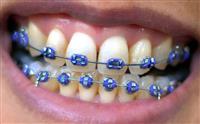 So when the day finally comes that your braces come off you will have beautiful straight teeth!
So when the day finally comes that your braces come off you will have beautiful straight teeth!
In the meantime you may be wondering how to treat that gingivitis which so often occurs with braces.
Braces and Gingivitis
It is difficult if not sometimes impossible to brush properly and floss between the teeth when you have braces. This is one reason that gingivitis is common with braces. So you have to take extra special care to achieve the oral hygiene that will keep gingivitis in check.
Brush More Often and Longer
As it is, most people rush through their brushing routine. One in two Americans over the age of 30 have some form of gingivitis due to poor oral hygiene. Dr Reitz, DDS says you should brush for at least 5 minutes under normal circumstances. So if you have braces you should make sure you are brushing at least that long!
Use an Orthodontic Brush or Orthodontic Floss
There are special toothbrushes like this one and special flossing devices
for use with braces. The brushes are called orthodontic brushes. These are designed to get into the hard to reach places and make oral hygiene with braces easier and more effective.
Remember! It is important to brush at least twice a day (morning and night) and to floss at least once a day (at night) whether you have braces or not. Brushing and flossing are essential to maintaining tooth and gum health.
Use an Oral Irrigator
A pulsating stream of water delivered between the teeth and along the gum line helps remove food and germs that create plaque which is a root cause of gingivitis. Additionally, a dental oral irrigator
can be used to deliver antibacterial agents…such as hydrogen peroxide or essential oils…to areas that can’t be reached by brush or flossing.
This is particular useful when braces make it double difficult to clean between teeth.
An oral irrigator is a helpful aid in the battle against plaque and should not be used to replace brushing or flossing, except where flossing is not possible.
I don’t have braces but I do use an oral irrigator to reach into and help clean the deep periodontal pockets that surround one or two of my teeth…a problem caused by chronic anaemia.
Keep Your Toothbrush Clean
Keep your toothbrush clean to avoid introducing germs that may exacerbate or contribute to gingivitis. Moisture and food particles trapped in your toothbrush provide an environment for germs to breed. So it is important to rinse your toothbrush well with hot water and stand it up in a holder or a glass to allow it to drain. Better yet give your toothbrush a chance to dry out complete by alternating between two or three toothbrushes. The germs will die in a dry environment.
Brush and Irrigate with an Essential Oil Toothpaste
If you’ve read any of the other pages on my site you’ll know that I am a big fan of OraMD. I cured my own gingivitis with it and I use it daily to prevent infections that might otherwise occur in the deep gum pockets mentioned.
The reason I think OraMD would be a good treatment for gingivitis with braces is the fact that the essential oil in OraMD fights bacteria and it lingers in the mouth for a long time killing bacteria. It does not rinse away easily.
Here’s a Quick Checklist of the Steps Discussed Above
- Brush more often and longer, 5 minutes at least!
- Brush with an orthodontic brush
.
- Use special flossing devices designed for braces.
- Use an oral irrigator.
- Keep your toothbrush clean.
- Brush with an non-toxic essential oil toothpaste.
If you have braces take extra care to avoid gingivitis.


